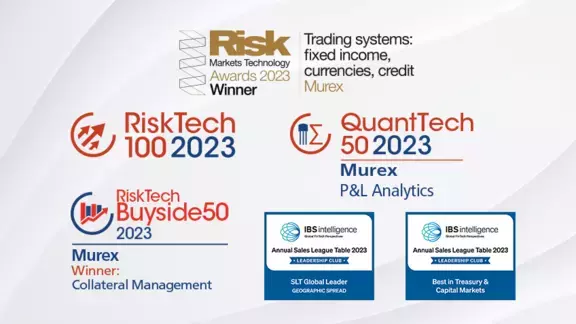-
Our solutions
- Our clients

With 300 clients and 60,000 users spread across 60 countries around the world, Murex has a truly international client base of capital markets participants.
view all case studies- Insights
- Who we are

Our awards highlight a strong level of customer satisfaction and acknowledge our market expertise.
Visit our awards webpage- Our partners
- Careers
Banorte Completes Strategic FRTB Project with Murex MX.3 Platform
Abraham Izquierdo, managing director of traded and treasury risks at Grupo Financiero Banorte, shares insights on the bank’s successful collaboration with Murex.

Can you describe your collaboration with Murex?
Our relationship with Murex has been highly successful. Banorte leverages Murex’s MX.3 platform across front and back-office operations, accounting, enterprise risk management, and regulatory compliance with the introduction, for example, of the Fundamental Review of the Trading Book (FRTB).
How did the collaboration with Murex begin?
In the past five years, the collaboration with Murex has helped Banorte progress from being behind our competitors to becoming a strong example of integrated banking tools in Latin America. This collaboration has allowed us to steadily enhance our offerings and make a meaningful impact in the region.
What were the initial steps in implementing Murex at Banorte?
We began with some of our front-office businesses, such as fixed income and derivatives. We developed pricing tools and risk factors for these areas, then expanded to back-office functionalities, collateral management, including IMM, settlement of transactions, credit counterparty risk, XVAs and now on market risk management, largely benefiting from Murex’s Upgrade as a Service allowing Banorte to profit from the latest product evolutions easily and frequently.
What challenges did you see when migrating market risk calculations in MX.3?
A major challenge was achieving reliable real-time functionality for online calculations. The complexity and computational demands for metrics like Potential Future Exposure (PFE), Value Adjustment (XVA), Value at Risk (VaR), market rates, expected shortfall, and greeks made this difficult. We needed to ensure that incremental risks, such as those arising from new trades or limit breaches, could be measured accurately and efficiently. Another significant challenge was implementing the Basel IV Fundamental Review of the Trading Book (FRTB). As the first local bank in Mexico to undertake this, we faced uncertainties about the exact regulatory requirements from the central bank, which meant we had to customize our methodology and take some assumptions to align with expected future regulations. Another challenge was to ensure that our market risk management system could efficiently monitor limits, sensitivities, and greeks in real time when traditionally this type of calculations requires heavy calculations of full revaluation. To fulfill this real time requirement, we used proxy calculations based on sensitivities and tailor expansion rules. This approach had to be both understandable for traders and reliable for risk monitoring.
What market risk measures, limits, or simulations are now being monitored in real-time?
We are now monitoring several market risk measures, limits and simulations in real-time. This includes:
1. Limits: Monitoring limits for various market risk metrics, including VaR and expected shortfall, to detect and manage limit breaches effectively.
2. Incremental risk: We measure the incremental risk of new trades or transactions in the portfolio to understand their impact on overall risk levels.
3. Greeks: Real-time monitoring of greeks (e.g., delta, gamma) to capture and manage the sensitivities of our portfolio to different risk factors.
4. VaR/ES based on Proxy calculations: thanks to the sensitivity-based proxy calculations approach for market risk we are able to make quicker and more efficient risk assessments. These real-time capabilities enhance our ability to manage market risk proactively and ensure compliance with regulatory requirements.
What benefits has Banorte realized since completing the market risk project?
We have achieved regulatory compliance, meeting central bank expectations for real-time risk management. Additionally, our risk management capabilities have significantly improved: having an integrated tool has been immensely beneficial. It ensures that everyone, from front office to risk management, speaks the same language, which reduces operational mistakes and speeds up our time-to-market. Overall, the integration of MX.3 into our operations has provided us with a unified approach to risk and front office processes, enhancing our operational efficiency and strategic capabilities.
How did the collaboration go with Murex, especially the completion of the full transition to FRTB requirements?
The collaboration has been fantastic. Our collaboration with Murex has been strategically important for Banorte. Throughout this journey, we’ve worked closely together, integrating various capabilities into our operations. This collaboration allowed us to leverage Murex's MX.3 regulatory solution to meet our complex requirements. Specifically, the collaboration between Banorte teams and Murex has been highly effective. Both teams have demonstrated strong coordination and commitment, ensuring seamless integration of MX. By migrating market risk, Banorte is able to integrate market & credit risk functionalities, with robust pricing & simulation engines, but also with the front, back & middle office capabilities. This collaboration was crucial as we undertook significant projects, such as developing front-office functionalities, implementing counterparty risk initiatives and enhancing our market risk management capabilities. Importantly, Banorte has also completed a full transition to the Basel IV FRTB requirements. This milestone makes us the first local bank in Mexico to achieve this, setting a precedent in the region. The FRTB implementation was particularly challenging, given the complexity of the regulations and the need to customize the methodology to align with expected future central bank requirements. However, with Murex's support and the integrated capabilities of their MX.3 platform, we successfully navigated these challenges, further solidifying our leadership in risk management and regulatory compliance in Latin America.
How important is having an integrated tool like Murex’s MX.3?
It's crucial. An integrated tool reduces operational mistakes, ensures consistency in pricing models, and improves time-to-market. It allows everyone to speak the same language, from front office to risk management.
How do you see the relationship between Banorte and Murex growing?
Going forward, we plan to continue expanding Murex capabilities within Banorte. This includes integrating new regulatory requirements such as the Basel SA for Counterparty Credit Risk, additional VAs, compliance with the IM & Derivatives regulations in Mexico & the new rules for repos, among others; but also introducing new product offerings, such as TRS and Credit Indices. We aim to expand the use of MX.3 to other branches of our financial group, utilizing its capabilities to meet diverse needs across our organization. We are focused on maintaining our position at the forefront of technological and regulatory advancements in the banking sector. By continuing to collaborate with Murex, we expect to enhance our operational efficiency, improve risk management and ensure compliance with evolving regulations. The strategic collaboration with Murex has been crucial for our success, and we look forward to furthering this collaboration to support our growth and innovation initiatives.
You might be interested in ...
- Our clients


